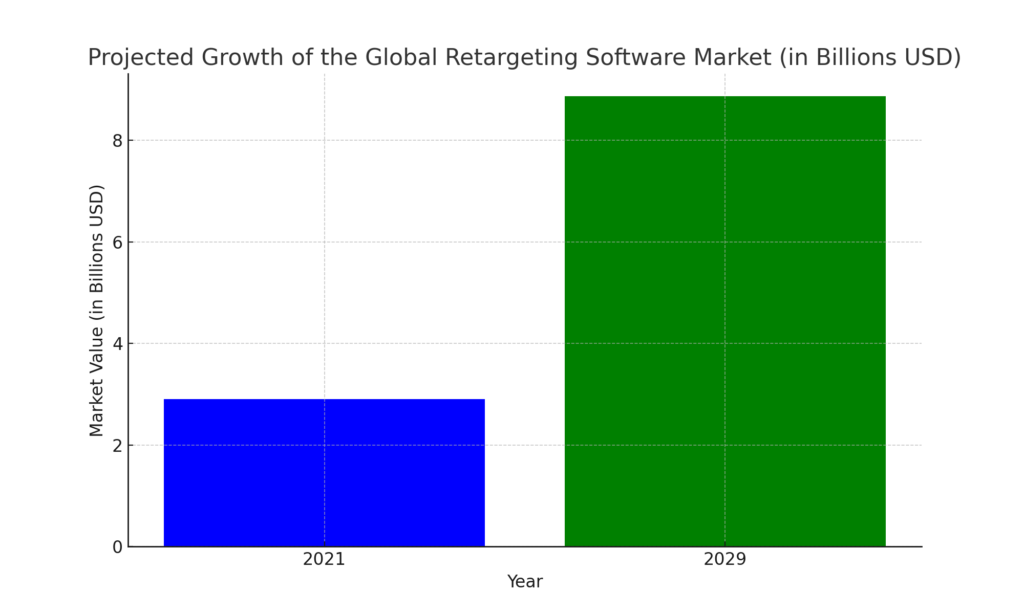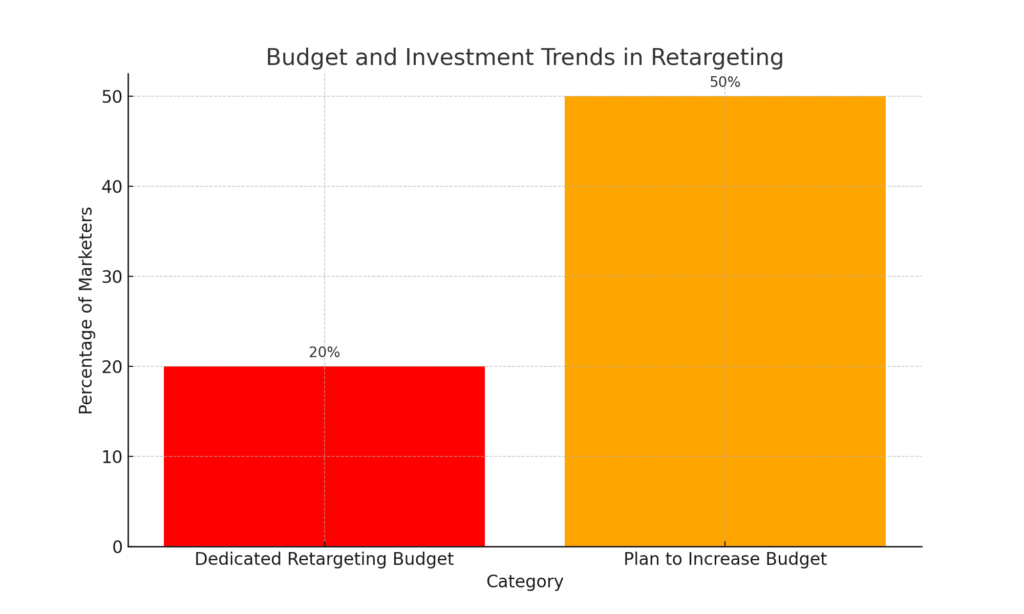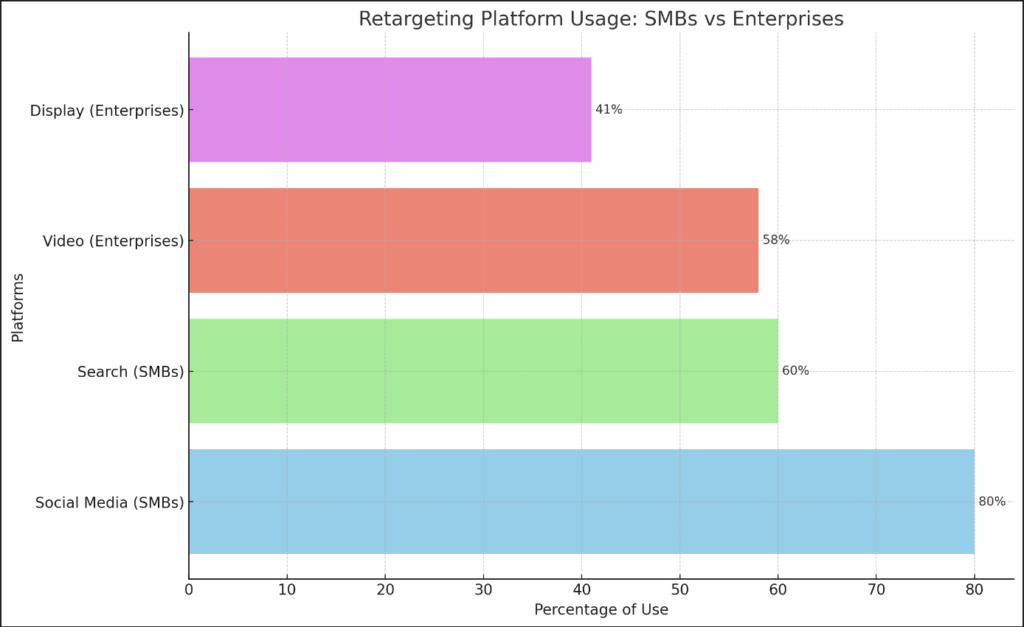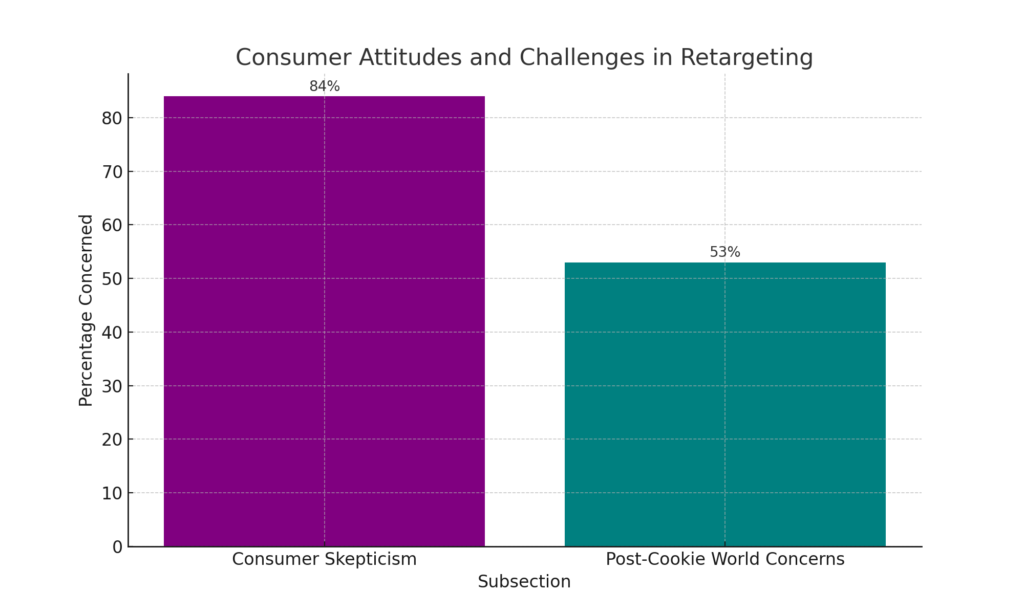The retargeting stats for 2024 are in, and they’re telling a compelling story: the global retargeting software market is projected to soar to $8.87 billion by 2029, up from $2.9 billion in 2021. This dramatic growth underscores retargeting’s critical role in digital marketing, where engaging past visitors can significantly boost conversion rates. Our goal? To arm journalists with the latest retargeting stats and trends for 2024, offering a peek into the future of digital marketing strategies. Let’s dive into what these numbers mean for the industry.
Table of Contents
Retargeting Stats (Top Picks)
- Market Growth: The retargeting software market is set to soar to $8.87 billion by 2029, up from $2.9 billion in 2021. This growth is fueled by the rise in cloud-based solutions and social media usage.
- Budget Prioritization: With 20% of marketers allocating specific budgets for retargeting and half planning to increase their spend, the value of retargeting ads is more recognized than ever.
- AI Integration: A whopping 88% of marketers are embracing AI to refine their retargeting strategies, highlighting tech’s role in boosting efficiency and outcomes.
- Social Media’s Role: Facebook and Instagram are key for 77% of marketers’ retargeting efforts, showcasing the pivotal role of social platforms.
- Privacy Challenges: Post-cookie privacy concerns are significant, with 53% of marketers wary of the impact on ad targeting’s effectiveness.
- Consumer Views: A notable 84% of consumers ignore or dislike retargeting ads, indicating the need for strategies that respect user sentiments.
- The Value of Repeat Visitors: Given that first-time visitors have a mere 2.4% conversion rate, retargeting’s ability to bring back and convert returning visitors—who represent 48% of ecommerce sales—is crucial.
- Retargeting Goals: Brands focus on boosting awareness, sales, and retention through retargeting, underscoring its comprehensive benefits.
- App Retargeting Success: With a 38% boost in app conversion rates and higher user retention, app retargeting proves to be a game-changer for engaging mobile users.
The Growing Importance of Retargeting
Market Growth:
The landscape of digital marketing is witnessing a remarkable transformation, with retargeting at its forefront. Projected to reach an impressive $8.87 billion by 2029, the global retargeting software market is testament to the strategy’s growing importance. This surge from $2.9 billion in 2021 not only highlights the effectiveness of retargeting in today’s digital ecosystem but also signals the increasing reliance of businesses on this method to reclaim and engage their audience.
Technological Advances:
Parallel to market growth, technological innovation, particularly Artificial Intelligence (AI), is revolutionizing retargeting strategies. A staggering 88% of marketers are now leveraging or planning to integrate AI into their retargeting efforts. AI’s role in analyzing vast amounts of data to identify patterns, predict user behavior, and automate personalized ad campaigns is indispensable. This technological leap enhances the precision and effectiveness of retargeting campaigns, ensuring that ads are not just seen but are also relevant to the viewers’ interests and behaviors.

Budget and Investment in Retargeting
As the digital marketing landscape evolves, so does the strategic allocation of budgets towards proven tactics. A notable trend emerging is the commitment of resources specifically for retargeting efforts. Currently, 1 in 5 marketers has carved out a dedicated budget for retargeting campaigns. This statistic underscores the recognition of retargeting’s value in converting interest into action and fostering brand recall among past visitors.
Looking ahead, the commitment to retargeting is set to deepen further. An impressive 50% of marketers are planning to increase their retargeting budget within the next six months. This surge in investment reflects a growing confidence in retargeting as a key driver for digital marketing success. Marketers are not just experimenting with retargeting; they are doubling down on it, anticipating higher ROI and enhanced customer engagement as they tailor their strategies to be more data-driven and personalized.

Platform and Channel Preferences
In the realm of digital marketing, the choice of platforms for retargeting campaigns speaks volumes about current trends and strategies. Among these, social media stands out as the undisputed leader. A staggering 77% of marketers leverage the power of retargeting on Facebook and Instagram, highlighting the dominance of social platforms in reaching and re-engaging audiences. This preference underscores the integral role of social media in modern retargeting efforts, attributed to its vast user base and sophisticated targeting capabilities.
When we delve deeper into platform usage across different business sizes, a nuanced landscape emerges. Small and Medium-sized Businesses (SMBs) and enterprises show distinct preferences in their retargeting strategies:
- SMBs exhibit a strong inclination towards social media and search, with a significant majority utilizing these channels for retargeting. This choice reflects the accessibility and effectiveness of these platforms in targeting specific audience segments without necessitating large advertising budgets.
- Enterprises, on the other hand, tend to diversify their retargeting efforts more broadly. While they also prioritize social media, there’s a notable shift towards video and display ads. This divergence is indicative of larger budgets and a strategic approach to leverage a wider array of touchpoints for retargeting, aiming to maximize reach and impact across various consumer touchpoints.
These trends not only illustrate the strategic considerations behind platform selection but also signal the evolving nature of retargeting as businesses strive to optimize their digital footprints across the most effective channels.

Consumer Attitudes and Challenges
The landscape of digital retargeting is not just shaped by technological advancements and market trends but also by the perceptions and responses of the consumers themselves. A significant aspect of retargeting strategy involves understanding and navigating consumer attitudes, which can often present both opportunities and challenges.
Consumer Skepticism:
A notable point of consideration is the level of consumer skepticism towards retargeting ads. Research indicates that a staggering 84% of users tend to ignore or express dislike towards retargeting ads. This figure highlights a prevalent challenge within digital marketing: bridging the gap between brand messaging and consumer receptivity. The data underscores the importance of crafting retargeting campaigns that are not only persistent but also relevant and engaging to the audience to mitigate the risk of ad fatigue and negative perceptions.
Post-Cookie World Concerns:
Another challenge looming on the horizon for marketers is the shift towards a post-cookie world. With 53% of marketers expressing concerns about the effectiveness of retargeting in the absence of third-party cookies, the industry is at a pivotal point. This transition calls for innovative approaches to track and engage users, emphasizing the need for first-party data and alternative tracking mechanisms that respect privacy while delivering personalized experiences. The post-cookie era represents a significant shift in digital marketing, compelling marketers to adapt their strategies to maintain the efficacy of retargeting campaigns in a changing digital landscape.
These insights into consumer attitudes and the evolving regulatory environment underscore the complexity of designing effective retargeting campaigns. Marketers are tasked with not just reaching their audience but doing so in a way that is both respectful and engaging, all while navigating the challenges posed by a rapidly changing digital ecosystem.

Retargeting Efficiency and Objectives
Conversion and Cost Efficiency:
Retargeting isn’t just effective—it’s efficient. Users already familiar with your brand are 8x cheaper to reach, making retargeting a cost-effective method to boost conversion rates. This efficiency stems from targeting users who have already shown interest, thereby increasing the likelihood of conversion without breaking the bank.
Marketing Objectives:
At its core, retargeting serves three key objectives: increasing brand awareness, boosting sales, and enhancing customer retention. By reminding users of their previous interactions with your brand, retargeting campaigns effectively keep your brand top of mind, encourage repeat visits, and ultimately, foster a loyal customer base. This strategic trifecta is what makes retargeting an indispensable tool in the digital marketer’s arsenal.
Retargeting Efficiency and Objectives:
| Subsection | Details |
|---|---|
| Conversion and Cost Efficiency | Retargeted users are 8x cheaper to reach, enhancing conversion rates. |
| Marketing Objectives | Primary objectives include increasing brand awareness, sales, and retention. |
App Retargeting Success
App Retargeting Effectiveness:
In the mobile-first world, retargeting shines brightly, especially within apps. Statistics reveal that app retargeting can boost conversion rates by 38%. It’s not just about nudging users; it’s about significantly enhancing user engagement, leading to more frequent visits and deeper interactions within apps.
Industry Adoption:
The adoption of app retargeting varies across industries, yet its impact is universally acknowledged. Food and drink apps lead with the highest retargeting adoption rate in North America at 62%, closely followed by shopping apps at 52%. This indicates a strategic pivot towards retargeting across diverse app categories, recognizing its potential to re-engage users and drive tangible outcomes.

Retargeting Platforms and Technology
Popular Platforms:
In the competitive landscape of digital advertising, certain retargeting platforms stand out for their efficiency and reach. At the forefront is Facebook Custom Audiences, a favorite among marketers for its precision targeting capabilities. By leveraging user data, Facebook enables brands to reconnect with visitors in a personalized manner, making it a powerful tool in the retargeting arsenal.
Marketers’ Preferences:
When it comes to selecting a retargeting solution, marketers prioritize platforms that offer access to target audiences and ease of use. However, there’s always room for improvement. Key areas include better customer service, more sophisticated ad spend optimization, and enhanced marketing and sales funnel integration. As technology evolves, the demand for platforms that can seamlessly adapt and offer detailed insights into campaign performance will only increase, guiding marketers towards more effective and efficient retargeting strategies.
Consumer Perspectives on Retargeting
Data Collection Comfort Levels:
Consumers show varying levels of comfort with the data collected by brands. While purchase history and personal preferences are generally acceptable, more sensitive information like browsing history sees a notable drop in comfort levels. This highlights the importance of transparency and trust in data collection practices.
Ad Fatigue:
The effectiveness of retargeting ads isn’t without its challenges, with ad fatigue being a significant concern. Consumers often feel overwhelmed by the frequency of ads, leading to a decrease in engagement over time. This reaction underscores the need for marketers to strike a balance between visibility and intrusiveness, ensuring that retargeting efforts enhance rather than detract from the user experience.
Here’s the summary table of contents for Consumer Perspectives on Retargeting:
| Subsection | Details |
|---|---|
| Data Collection Comfort Levels | Consumers are generally comfortable with brands collecting purchase history and personal preferences, but less so with browsing history. |
| Ad Fatigue | Ad fatigue is a concern, with consumers feeling overwhelmed by frequent retargeting ads, highlighting the need for a balanced approach. |
Conclusion
As we navigate through the evolving landscape of digital marketing, the insights from the latest retargeting statistics and trends illuminate a path forward. The growth of the retargeting market, alongside technological advancements and shifting consumer attitudes, underscores the undeniable importance of retargeting in crafting effective digital strategies. Yet, as we embrace these opportunities, we must also navigate the challenges ahead, from adapting to a post-cookie world to balancing consumer engagement with privacy concerns.
For journalists covering the dynamic field of digital marketing, these insights offer a valuable lens through which to explore and report on the trends shaping our digital interactions. By considering the nuances of retargeting strategies and their impact on both brands and consumers, we can foster a more informed and nuanced discourse on the future of digital marketing.
For more relative content check out: Social Media Following, AI Market Stats, Generative AI Market, Referral Marketing Saas, Saas Industry Growth, Social Proof Stats, ChatGpt User Statistics, and Number of AI companies.
Source: SharpSpring, Marketing Charts, Upland, Criteo, Built With





